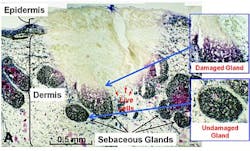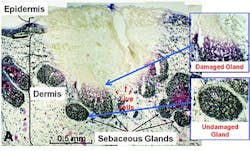Minimally invasive, all-fiber laser promising for acne treatment
An all-fiber laser developed at the University of Michigan (U-M; Ann Arbor, MI) can melt fat without burning surrounding tissue, making it promising for treating acne. Described in a paper published in Lasers in Surgery and Medicine, the laser's 1708 nm, infrared beam can be absorbed by fat more efficiently than by water. Therefore, the beam can penetrate skin with minimal harm on its way to reach and destroy deeper pockets of fat, says Mohammed Islam, a professor of electrical engineering and internal medicine.
The laser could treat acne by targeting the oil-producing sebaceous glands more than 1.5 mm beneath the skin, which are known to be involved in the development of acne.
Dr. Jeffrey Orringer, an associate professor of dermatology at the U-M Medical School, says that their laser system development could alter sebaceous glands in the skin and thereby impact the pathogenesis of acne. He notes that there could be several other potential uses for the system as well.
To prevent superficial burns, the researchers found that they had to first cool the skin before treating it. They performed the experiments on human samples that had been removed due to their proximity to non-melanoma skin cancers.
The U-M team is not the first to think of this type of treatment, but they are believed to be the first to propose doing it with off-the-shelf telecommunications technology. Islam notes that there were experiments like theirs being done using a free electron laser, which, due to its extremely large size, wasn't a practical light source. The research team has taken their years of experience in the field to build a laser that is compact, low-cost, and has real potential to make it to the marketplace, he says.
The University of Michigan Cardiovascular Center and U-M spinout company Omni Sciences, Inc. supported this work. Islam is the founder, president, and chief technology officer of Omni Sciences, which has licensed Islam's technology from U-M.
-----
Follow us on Twitter, 'like' us on Facebook, and join our group on LinkedIn
Follow OptoIQ on your iPhone; download the free app here.
Subscribe now to BioOptics World magazine; it's free!

